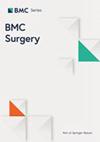Efficacy of thoracic endovascular aortic repair versus medical therapy for treatment of type B aortic dissection
IF 1.6
3区 医学
Q2 SURGERY
引用次数: 0
Abstract
Techniques in endovascular therapy have evolved to offer a promising alternative to medical therapy alone for Type B aortic dissections (TBADs). The aim of this meta-analysis was to compare mortality and overall complications between thoracic endovascular aortic repair (TEVAR) and best medical therapy (BMT) in patients with TBADs. We included randomized control trials and prospective or retrospective cohort studies that compared TEVAR and BMT for the treatment of type B aortic dissection. Multiple electronic databases were searched. Thirty-two cohort studies including 150,836 patients were included. TEVAR was associated with a significantly lower 30-day mortality rate than BMT (RR = 0.79, CI = 0.63, 0.99, P = 0.04), notably in patients ≥ 65 years of age (RR = 0.78, CI = 0.64, 0.95, P = 0.01). The TEVAR group had a significantly prolonged hospital stay (MD = 3.42, CI = 1.69, 5.13, P = 0.0001) and ICU stay (MD = 3.18, CI = 1.48, 4.89, P = 0.0003) compared to the BMT. BMT was associated with increased stroke risk (RR = 1.52, CI = 1.29, 1.79, P < 0.00001). No statistically significant differences in late mortality (1, 3, and 5 years) or intervention-related factors (acute renal failure, spinal cord ischemia, myocardial infarction, respiratory failure, and sepsis) were noted between the groups. Our meta-analysis revealed a significant association between the TEVAR group and a decreased mortality rate of TBAD compared to the medical treatment group, especially in patients aged 65 years or older. Further randomized controlled trials are needed to confirm our findings.胸腔内主动脉血管修补术与药物疗法治疗 B 型主动脉夹层的疗效对比
血管内治疗技术不断发展,为B型主动脉夹层(TBAD)患者提供了一种替代单纯药物治疗的可行方法。这项荟萃分析旨在比较胸腔内血管主动脉修复术(TEVAR)和最佳医疗疗法(BMT)在 TBAD 患者中的死亡率和总体并发症。我们纳入了比较 TEVAR 和 BMT 治疗 B 型主动脉夹层的随机对照试验和前瞻性或回顾性队列研究。我们检索了多个电子数据库。共纳入 32 项队列研究,包括 150,836 名患者。TEVAR 的 30 天死亡率明显低于 BMT(RR = 0.79,CI = 0.63,0.99,P = 0.04),尤其是在年龄≥ 65 岁的患者中(RR = 0.78,CI = 0.64,0.95,P = 0.01)。与 BMT 相比,TEVAR 组住院时间(MD = 3.42,CI = 1.69,5.13,P = 0.0001)和 ICU 住院时间(MD = 3.18,CI = 1.48,4.89,P = 0.0003)明显延长。BMT 与中风风险增加有关(RR = 1.52,CI = 1.29,1.79,P <0.00001)。在晚期死亡率(1 年、3 年和 5 年)或干预相关因素(急性肾功能衰竭、脊髓缺血、心肌梗死、呼吸衰竭和败血症)方面,两组间无统计学差异。我们的荟萃分析显示,与药物治疗组相比,TEVAR 组与 TBAD 死亡率降低之间存在显著关联,尤其是在 65 岁或以上的患者中。我们需要进一步的随机对照试验来证实我们的研究结果。
本文章由计算机程序翻译,如有差异,请以英文原文为准。
求助全文
约1分钟内获得全文
求助全文
来源期刊

BMC Surgery
SURGERY-
CiteScore
2.90
自引率
5.30%
发文量
391
审稿时长
58 days
期刊介绍:
BMC Surgery is an open access, peer-reviewed journal that considers articles on surgical research, training, and practice.
 求助内容:
求助内容: 应助结果提醒方式:
应助结果提醒方式:


